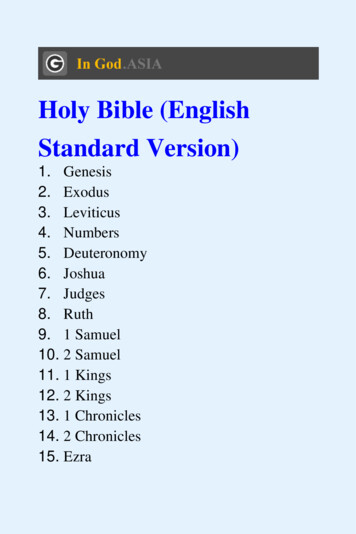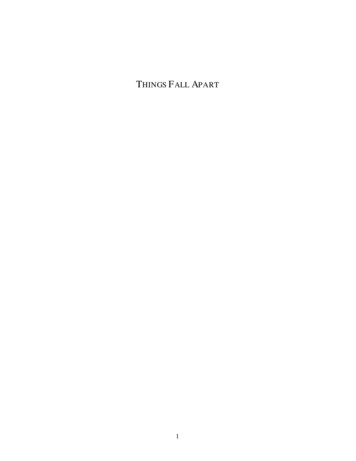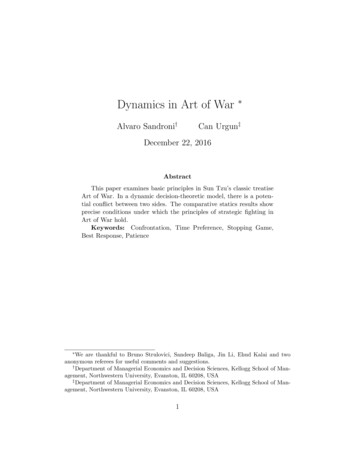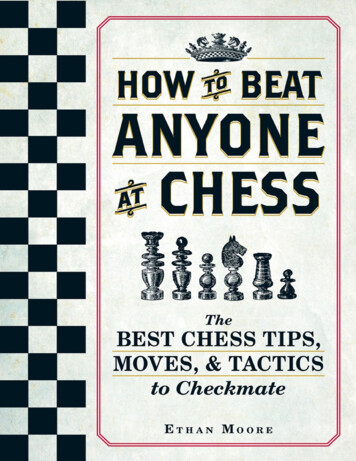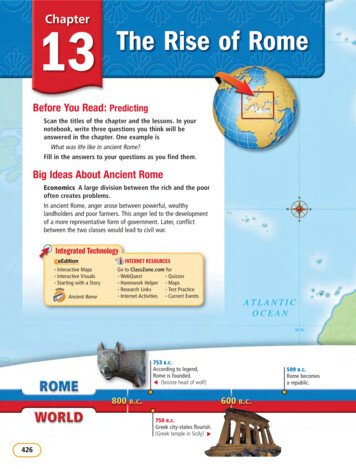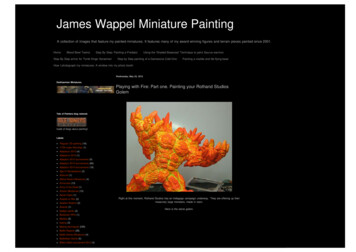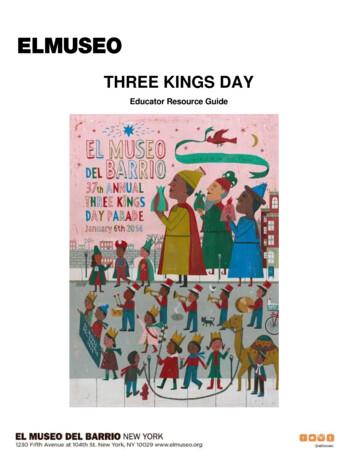
Transcription
THREE KINGS DAYEducator Resource Guide
Educator Resource Guide: THREE KINGS DAYTABLE OF CONTENTSPart I.Three Kings Day History and Traditionso History of the Three Kings Day Traditiono The Story of the Three Kingso The Nativityo The Origin and Iconography of the Three Kingso The Gifts of the Three Kingso Santos de Palo Carvingso Latin American and Caribbean Customso Las Parrandas & Musical Traditionso Three Kings Day Parades and Festivalso El Museo’s Three Kings Day PuppetsPart II.Preparing for Your Visit to El Museo del BarrioPart III.Linking Three Kings Content to a Visit at El Museoo Activity 1: Three Kings Maracaso Activity 2: Three Kings Crownso Activity 3: Three Kings CapesPart IV.VocabularyPart V.Resourceso Bibliographyo WebographyCREDITS AND ACKNOWLEDGEMENTS2
Educator Resource Guide: THREE KINGS DAYPART I: Three Kings Day History and TraditionsHistory of the Three Kings Day TraditionAlthough we usually take today’s Christmas celebration customs for granted, most of the so-called‘traditional’ Christmas practices we are familiar with only date back to the 19th century in the UnitedStates. It was in the 4th century that the Roman Catholic Church adopted December 25 as theChristmas holiday, choosing a date that coincided with pagan festivals of the Winter solstice. Prior tothis date, January 6 was the Christian day of celebration in many parts of Europe, including Spain,Italy, Austria, Germany, and Switzerland. Even today, throughout Europe, the holiday celebrationdoes not end until this date, marking the end of the ‘twelve days of Christmas’ between Christmasand January 6. This is also often referred to as the Twelfth Day. In the United States, the holidayseason for most ends after New Year’s Day, however, for some Latinos the festivities continuethroughout the months of January and early February. In some Latin American and Caribbeancountries, Three Kings Day, or El Día de Reyes, is celebrated annually as one of the most joyous daysof the holiday season. The day is also sometimes referred to as El Día de los Tres Reyes Magos or Dayof the Three Wise Kings. Observed on January 6, it is recognized by Christians as the Epiphany, a feastday in the Anglican, Eastern, and Roman Catholic churches that commemorates the biblical story ofthe Three Kings who followed the star of Bethlehem to bring gifts for the infant Jesus. Like Christmasor Navidad, in some Spanish-speaking countries including Spain, Puerto Rico, Cuba, the DominicanRepublic and Mexico among others, Three Kings Day is a religious holiday that has become a popular,cultural event. Celebrated with music, singing, family gatherings, and the sharing of food, Three KingsDay is a holiday that conveys the spirit of giving. The tradition promotes a sense of community, andemphasizes diversity, sharing, and reciprocity.The Story of the Three KingsDuring the 1st century, astrologers, or seers of the future, foretold the advent of a divine king who wasbelieved to be born God incarnate. Many argued about who would be the divine king as well as whenand where he would arrive. The most commonly agreed prediction was that a child would be born andthat he would be named Emmanuel, meaning ‘God is with us.’ Astrologers predicted this child wouldbring peace and ultimately change the course of history. It is said that the Three Kings may havepracticed astrology, and thus may have each seen this prediction forecast in the stars. The Kings arealso known as the Three Wise Men or the Magi. Magi is plural for magus, a word that may refer toshaman or ‘wise man’ and is the origin of the words magic and magician. In ancient Persian cultures,the magi were responsible for funerary and religious rites.According to the Gospel of Matthew (2:1–13), the only biblical account of the event, the Magi came from“the East” to first visit Herod (appointed governor of Judea by the Roman Empire) in Jerusalem,asking him where the new King could be found. Herod, troubled by the news of a new king, sentthem to Bethlehem, and asked that they return when they had found him. According to legend, inorder to greet the infant Jesus, the Magi traveled over a long distance guided night and day by a brilliantstar that shined in the sky. The legend states that the Star of Bethlehem was located directly overheadof the location where the infant Jesus was born. When they arrived, they appeared before the baby,and offered him gifts of gold, frankincense, and myrrh.The NativityDuring the holiday season, many Latin Americans and Latinos erect nativities, small or sometimeslife-sized figures representing the scene of the birth of Jesus, in their homes, in Churches, and inpublic spaces. As the legend describes, the nativity scene, known in Spanish as el nacimiento, is3
Educator Resource Guide: THREE KINGS DAYusually set in a humble stable, with the figures of Mary and Joseph, as well as shepherds and theiranimals. The figure of the baby Jesus is added on December 25, the day he was thought to be born.The Nativity refers to the birth of Jesus and the many depictions of the scenery of his birthplace andthose who were present. Although he was thought to be as important as a king, he was not a wealthyking who was born in a palace, but rather in a very humble setting. Two legendary stories telldifferent situations about where the Three Kings discovered the infant Jesus. The most popularlyaccepted story states that having just traveled backto Bethlehem, where Jesus’ father Joseph was from,there was no place for the family to stay. A kind manallowed them to spend the night in his stable. Otherstories maintain that Jesus and his family were foundsheltered in a cave. When the Three Kings reachedthe baby Jesus, he was resting on a humble bed ofhay in a manger or pesebre, a trough for feedinganimals. The baby’s mother, Mary, and his father,Joseph welcomed the Three Kings and received theirgifts. Also among them were sheltered animalsincluding sheep, donkeys, and oxen. Curiousshepherds were gathered to view the newborn, whothey believed to be their divine king.Nacimiento (Nativity), 1996El Museo del Barrio, NYIn parts of Latin America and the United States, CollectionThe Chase Manhattan Corporation, F99.4.1-21Mary and Joseph’s search for shelter is re-enacted Installed at El Museo del Barrio, Dec 12, 1999–Jan 6, 2000during Las Posadas, a nine-day celebrationbetween December 16 and Christmas Eve. During these special celebrations, a family may host aparty at their home to welcome the arrival of a nativity procession. The family and shepherds seekingshelter, played by children, are followed by musicians and adults who sing carols outside the home.The event concludes with the sharing of traditional foods and the breaking of a piñata. Also inMexico, pastorelas, or shepherds plays, are staged throughout the holidays by professional andamateur groups. These traditional, often improvised, theatrical presentations date back to Mexico'sColonial period, and tell the story of the shepherds’ and Three Kings’ journey to find the infant Jesusin Bethlehem. In some countries, a special celebration of the nativity is held on January 5, the Eve ofThree Kings Day. This day is also referred to as La Vispera de Reyes. Children dress up ascharacters of the nativity and perform in plays or pageants that recount the story. On this day familiesalso add the figures of the Three Kings to the nativity scene in their home or in public spaces. Insome cases, like the Three Kings, visitors to the nativity bring gifts of money or food to offer the infantJesus.The Origin and Iconography of the Three KingsIn the story described in the Bible’s Book of Matthew, the Three Kings are said to have come fromthe East. If they were traveling to Bethlehem, then it can be surmised that they came from either Asiaor Africa. However, again generations recount the story in a myriad of ways. Christian depictions asearly as the 6th century represent the Three Kings in Persian garb. In the 13th century, Marco Polo’swritings refer to the Kings as having hailed from Persia or present-day Iran. Parts of this story as toldtoday are attributed to another book written in the 14th century, History of the Three Kings, by thecleric John of Hildesheim, who states that the Kings hail from "Ind, Chaldea, and Persia,” referring toIndia, Babylon (or present day Iraq), and Iran. Still other accounts tell of each King having traveledfrom a different part of the world, specifically Europe, Africa and Asia. It is believed that this versionof the story dramatizes the arrival of various nations from different continents into the Christian faith.A similar personal twist has been added to the story in Puerto Rico and other parts of Latin America,4
Educator Resource Guide: THREE KINGS DAYwhere the origin of the Three Kings is believed to represent the three dominant ancestries of theregion: indigenous, African and European.Although the Bible’s Book of Matthew does not specify the total number of kings that came to visitJesus, nor their names or their specific places of origin, in the West, the Three Kings are widelyrecognized as Melchior, Caspar, and Balthasar. As the scripture mentions three gifts were offered,perhaps it was assumed that there were three kings.Melchor (or Melchior) was known to have brought the giftof gold to Jesus. As one of the most precious metals,gold is a symbol of charity, suitably fit to be a giftbestowed for a king. In many accounts Melchor was anArabic sultan or ruler. In Puerto Rico and other parts ofLatin America he represents a Moor or Northern African.In this way, Melchor references the Moorish heritage ofSpain since most of Spain was under Moorish rule foreight hundred years. This is still a similar representationas the Moors in Spain spoke Arabic. However in PuertoRico he is represented with a dark brown complexion,thus representing not just Northern Africans, but thepeople of the whole continent of Africa. Melchor’s feastday in the Catholic Church is January 7.Eduardo Vera CortézPrograma de Navidad, 1978Published by: División de Educación de laComunidad (DivEdCo)Collection El Museo del Barrio, NY, W91.920.2Gaspar (also known as Caspar, Casper or Jasper) isusually represented as an emperor of the Orient. He isdepicted as a youth of light complexion. Because of hisyoung age he is seldom depicted with a beard. In somecases he is believed to be of Asian origin. Caspar isassociated with the gift of frankincense. In Puerto Ricoand other parts ofLatin America, he is often represented with a bronzecomplexion and is believed to represent the indigenousheritage of Latin Americans. His feastday in the Catholic Church is January 6.In European accounts and in some Latin Americancountries, Balthasar (also known as Baltasar or Baltazar) is depicted as a Nubian prince fromEthiopia. For this reason he is represented as a man with a dark brown complexion. He is believed tohave brought the gift of myrrh, a resin from trees native to Africa. As Ethiopia is regarded by someas the birthplace of Christianity, it is significant that this region of Africa is represented in the legend.However, considering that in Puerto Rico and some other Latin American countries, Melchorbecomes the King to represent the continent of Africa, the significance of Balthasar changed torepresent a king from the West, or rather a European king of a pale complexion. In this way,Balthasar in some parts of Latin America represents the European presence that arrived in the late 15 thcentury. His feast day in the Catholic Church is January 8.The Gifts of the Three KingsEven though the Three Kings did not know who Jesus was, they predicted that a child who wouldbecome king was born in Bethlehem. To honor the infant, the Three Kings carried gifts fit to bestow aking. Legend states that the gifts consisted of gold, myrrh, and frankincense, brought as symbols ofcharity, hope and faith. Each of the Kings transported their gifts in ciboria, ornate containers or vessels.5
Educator Resource Guide: THREE KINGS DAYThe Kings did not expect anything in return, other than the opportunity to meet this new baby king.This tradition is slightly different than what we associate with the holidays today as it does notrepresent a gift exchange. Additionally, the gifts offered by the Three Kings had a much morespiritual or symbolic value rather than a material value.Many Christians believe that it was Melchor who brought the gift of gold to Jesus, although in somecases this gift is associated with Caspar. Gold is a precious metal that is widely coveted around theearth by different people. It is a symbol of royalty and was offered to Jesus to mark him as an “earthlyking.” According to the legend surrounding the holiday, at the time Jesus was born, King Herodlearned that three wise men or Magi were searching for a newborn king. Feeling threatened hedemanded that the Magi inform him of the baby king’s whereabouts. Instead the Magi secretly leftBethlehem, never informing Herod of the baby they had just met. In retaliation, Herod ordered that allbaby boys born in Bethlehem be killed. Jesus’ family was instructed to flee to Egypt where he wouldbe safe. It is believed that the gift of gold from the Three Kings financed the family’s long trip to Egyptfrom Bethlehem.The gift of myrrh is usually associated with Balthasar. Although in the Puerto Rican community he isthought to be of European descent, elsewhere he is commonly viewed as a Nubian king fromEthiopia, a place where myrrh is of high importance and readily available. Myrrh is a type of resin thatcomes from the sap of a tree in Africa and is collected collected for the purpose of burning incensemostly. Myrrh is believed to have medicinal and spiritual properties. It is said that Jesus was offeredthe gift of myrrh because if he accepted it, then it would mark him as a healer. In biblical stories, thechild did accept the myrrh and his short life was characterized by miraculous acts in which he wasable to heal various people.In many places in Latin America, frankincense was thought to have been brought by King Caspar.In other places, frankincense is associated with King Balthasar. Similar to myrrh, frankincense iscollected from the sap of a special tree. It is mostly found in Somalia, a country in North Africa thatborders Ethiopia and Kenya, and from the Middle Eastern country of Arabia. In the time of Jesus andthe Magi, kings were not necessarily crowned but were instead anointed with precious perfumed oilsin a special ceremony. Frankincense has the same association to royalty as it was a precious scentused by important people such as kings and priests. As such, it was used by the Magi to anoint thenew baby king. It is said that the gift of frankincense was brought with the intention that if the babyJesus accepted it, it would mark him as a god. As incense, frankincense is still burned andassociated with prayer in many churches throughout the world, including the Roman CatholicChurch. Another use for frankincense was found among the Egyptians who burned the charredpowder into kohl, a black substance they used to create the thick eyeliner seen in so many examplesof Egyptian art.6
Educator Resource Guide: THREE KINGS DAYSantos de Palo CarvingThroughout the last millennium, images of the Three Kings havegraced frescoes, mosaics, murals, canvases, and other works ofart. The earliest images date back to catacomb paintings of the 4thcentury. Many scenes have been recreated by artists as “theadoration of the magi,” depicting the Three Kings’ visit to the babyJesus. Their images have been recreated over and over againthroughout the world. Over generations, the three Magi werehonored as declared saints in the Catholic Church and are stillviewed by some as powerful miracle makers. For this reason, wefind a vast amount of representations of the Three Kings withinanother genre of art, the santos de palo, or wooden saints traditionof Puerto Rico. This long-standing tradition entails carefully carvingand sculpting wood into three distinct miniature forms of the ThreeKings. Santeros, who are specially trained wood carvers, createthese miniature models of the Three Kings, other Catholic saints, andeven carvings of the Nativity, a display of the newborn Christ childwith his family and adoring visitors.Rafael TufiñoEl santero (The Saintcarver), 1967Published by: División de Educación de la Comunidad(DivEdCo)Collection El Museo del Barrio, NY,W91.1493, Photo by Jason MandellaPhoto courtesy El Museo del Barrio, NYMany people associate the term santero with a practitioner of theAfro-Cuban faith, Santeria. However in Puerto Rico, santero is thename given to a master saint carver. These saints are carvedfrom wood. They can then be left natural or be painted in brightcolors. Almost four hundred santos are found in El Museo del Barrio’s Permanent Collection. Mostwere created by Puerto Rican artisans or santeros, working from 1850-1940. Many santeros werepart of families who passed the tradition down for generations. The Cajigas and the Cabáns are twosuch families. Although this tradition is highly respected in Puerto Rico, carved saints can be foundthroughout Latin America. They were inspired by color chromolithographs of saints that were broughtto Latin America from Spain. The Spanish would use these images to convert native people andAfricans to the Catholic religion. In the early colonial period, there were few churches nearby so itbecame custom to have a small altar in the home on which these wooden saints would be displayed.During the time of the holidays, santos de palo of the Three Kings were often added to thesepersonal altars.The great number of Three Kings santos de palo in existence demonstrates their enormouspopularity throughout Latin America and the Caribbean. Today, during the months preceding theholiday festivities, they are usually prominently placed on a communal altar while velorios de reyes,vigils, and prayers are observed. Many trulleros or parranderos, door-to-door carolers, hold the ThreeKings’ images or bear santos de palo figures of the Three Kings in their arms with the hope of bringinggood luck and health. Some people even make special promises to the Three Kings to ensure thattheir prayers or wishes come true. If their prayers are answered, on January 6, that person must fulfillthe promise that s/he has made to the Three Kings. People even set off fireworks or build specialdedication altars in celebration of this fulfilled wish. This custom is known as La Promesa de losReyes.7
Educator Resource Guide: THREE KINGS DAYThe iconography of the Kings and the orderin which they are positioned varies slightlybased on the place where the figure wascarved. But most commonly, as seen in thePuerto Rican carving tradition, King Melchoris centrally positioned between the other twoKings. King Melchor is considered to be themost generous, which may explain hiscentral position in the group. In Caribbeanand Puerto Rican folk art, the Three Kingsare depicted riding on horses, once acommon mode of travel on the island afterthe Spanish colonized the region. At thesame time, the use of the horse in thesefigures reflects the environmental reality ofthe islands, as camels are not found in thistropical climate. Melchor, Gaspar andBalthasar wear elaborate crowns, capes,and regalia, and are often pictured with a Unidentified artist from Puerto RicoTres Reyes (The Three Kings), late 19th-early 20thsingle star and carrying the ciboria. The Loscentury, Collection El Museo del Barrio, NYstar is an important symbol of their Gift of Dr. Victor de León Hernández, F91.770voyage to welcome the infant Jesus, andthe ciboria represent the Three Kings’ generous nature.In Los Tres Reyes, a work from El Museo’s collection shown above, each King appears as a single unitriding on the back of their steeds, and is attached to a small, flat, undecorated wooden base. KingsBalthasar and Gaspar, who ride on black and brown horses, respectively, flank King Melchor, riding on awhite or light gray horse. The Three Kings wear long flowing mantles and small, cusped or jaggedcrowns adorn their heads. Each one has their arms outstretched, as if to carry a small box or gift whichperhaps was lost over time. Despite the fragility and decay of these wooden sculptures, we are fortunatethat fine examples of the santos de palo carvings survive today and continue to play an important role inthe celebration of the Three Kings Day holiday.8
Educator Resource Guide: THREE KINGS DAYLatin American and Caribbean CustomsMany countries throughout Europe have celebrated Three KingsDay for centuries. One such place, Spain, in its colonial rule ofLatin America, introduced this holiday and its traditions to this partof the world. Overtime, each country adapted and expanded uponthe Spanish Three Kings traditions, celebrating in various ways onJanuary 6. Although European in origin, the tradition of SantaClaus and gift exchange on December 25 was not introduced on amass level in Latin America until the increase of Americaninfluence in the 20th century. Furthermore, Santa Claus and hisassociation to snow and the cold North Pole was hard to envisionin the tropical climates of Latin America. Although we do finddeserts and snow in parts of Latin America, none of these regionsare so vast as to have influenced the stories associated with theholidays.Today, many people in Latin America and the Caribbean and thoseof Latin American descent living in the United States, continue tofollow the Three Kings’ tradition. Most notably the traditions of giftgiving, singing of aguinaldos (holiday carols), parrandas (door-to- Antonio Maldonadode Navidad, 1971door caroling), and the sharing of food and sweets embody the ProgramaPublished by División de Educación de la Comunidadkind spirit of the Three Kings. Although some of these customs (DivEdCo)Collection El Museo del Barrio, NY, W91.852.2may vary slightly from place to place, the message of sharing withfriends and family is a common theme that is celebrated in similar rich and festive ways.Mirroring the gifts offered by the Three Kings, many people in Puerto Rico, Mexico, and other LatinAmerican and Caribbean countries exchange gifts or regalos on January 6. Although today manypeople have adopted the U.S. custom of exchanging gifts on Christmas Day, most still reserve a fewgifts to open twelve days later on Three Kings’ Day. Young children wait for this day with greatanticipation, eagerly waiting to receive special gifts from ‘the kings’ or their parents, families, and friends.In Puerto Rico, the spirit of benevolence is returned to the Kings as exemplified by the gifts offered byyoung children and their parents on the Eve of Three Kings Day. Given the island’s tropical climate, thePuerto Rican tradition recognizes that the Kings rode horses instead of camels on their journey. In lightof this, on the Eve of Three Kings Day, or La Vispera de Reyes, children gather grass, hay, and waterand place it in shoeboxes under their beds to feed the Kings’ horses. Some children also set out theirshoes next to the boxes under the bed. Their parents often set out pastries or sweets for the ThreeKings. On Three Kings Day morning, children discover the pastries and food left for the Kings andanimals are gone. Instead, the food is replaced with gifts, candy, or nuts that the Kings have left forthem. Similarly, in Mexico, children write letters to the Three Kings requesting special gifts analogousto the tradition of writing a letter to Santa Claus. On the Eve of Three Kings Day, children leave theirshoes near their bed or window, often filling them with hay for the camels and horses. The nextmorning, when the children wake up, the hay is gone and the shoes are filled with gifts.9
Educator Resource Guide: THREE KINGS DAYThree Kings Day is a special and significant holiday for adults,as well as their children. During this holiday, it is common forfamily and friends to have parties and gatherings to feast onfood and drink. Although many people in Latin America sharetraditional cuisines, there are some distinctions between foodsthat are served and enjoyed by people from different countriesfor this holiday. For example, in Puerto Rico, people eat savoryfoods like pasteles, or sweet tamales with meat, as well as arrozcon gandules, a popular dish comprised of rice and beans. Tastysweets typically shared consist of pastries, sweet rice puddingcalled arroz con dulce, and tembleque, a molded jello-like treatmade with coconut milk. Frequently in the Caribbean, largegroups of friends and family gather for a special feast of lechónasado, which is an open-fire pig roast. In addition to being ahearty feast for many, the process of keeping watch over thespeared lechón as is rotates on its axis for many hours, and thegroup preparation of other foods to be shared, is an integral partof the Three Kings’ Day celebration.In Spain and many Latin American countries, people enjoyRosca de Reyes, or ‘King’s Cake,’ a crown-shaped sweet breaddecorated with candied fruits to resemble jewels. Well-loved bymany, this bread is filled with nuts, figs, and cherries, and isfrequently given and shared as a gift with friends. Hot chocolateoften accompanies the rosca. Inside the rosca, one or more tinyfigures of babies are hidden. On January 6, at family gatherings and parties, each guest cuts their ownpiece of the rosca, hoping to avoid the piece with the baby, representing the infant Jesus. In Mexico,those who are unlucky enough to bite into a piece containing the figure are obliged to throw a party on orbefore February 2, which is called El Día de la Candelaria, or Candlemas, offering tamales and atole (ahot, sweet drink thickened with corn flour) to their guests. El Día de la Candelaria is the ‘Day of theCandle’ or ‘Light,’ also known as the ‘Day of Purification.’ In addition to a party thrown by the ‘victim’ ofthe rosca, this is the day that the Nativity scene is put away, marking the official end of the holidayseason. In other countries, finding the baby figure is a promise of good luck for the new year. Varioustraditional beverages are served during the holiday season throughout Latin America, the Caribbean,and the United States. In the Puerto Rican tradition, people enjoy coquito and ponche. Coquito is aneggnog drink that can be prepared as a non-alcoholic beverage or mixed with coconut rum. Likewise,fresh ponche, or punch can be made and served to adults as a fruity alcoholic or non-alcoholic softdrink. In Mexico, ponche (a hot fruit punch), sidra (sparkling cider) or other spirits are served for theholiday brindis (toast).Antonio MaldonadoPrograma de Navidad, 1980Published by División de Educación de la Comunidad(DivEdCo)Collection El Museo del Barrio, NY, W91.853.3Visiting with family, friends, and neighbors is of central importance in the Latin American and Caribbeantradition and occurs before, during, and after the Three Kings’ Day holiday. Las Octavitas formallyextends the Three Kings’ holiday for eight days of continued gatherings. Popular practice states that if afriend, neighbor, or family member visits you on Three Kings’ Day, you must return the visit to them eightdays later. This exchange of visits is understood as a type of gift or offering and may include song andprayer.10
Educator Resource Guide: THREE KINGS DAYLas Parrandas & Musical TraditionsIn Puerto Rico and other Latin American countries, theparrandas tradition, door-to-door caroling, entails visiting friendsand neighbors door-to-door, singing cheerful holiday carols. InPuerto Rico, aguinaldos are traditional songs or offeringscommonly sung during the Christmas and Three Kings holidayseason. The adult carolers may also play musical instrumentslike the güiro, cuatro, and maracas. With early roots in Europe,the aguinaldo songs stem from a religious practice in theCatholic Church liturgy, known as la misa de aguinaldo, whichis incorporated into Christmas and Three Kings’ Day holidaymass services. In the Middle Ages, villancicos, an earlier form ofholiday carols, were sung and performed in dramatic plays.Often, a Nativity scene was the backdrop for this musical poetry,equipped with the infant Jesus, his parents, animals, and asinging choir of performers who represented the visiting ThreeKings, shepherds, and other patrons.In Cuba and Puerto Rico, regional peasants or country folk,known as jíbaros in Puerto Rico and guarijos in Cuba began toRafael Tufiñosing aguinaldos in groups called trullas. The practice began inFelicidades, 1976thSilkscreen, 24 7/8 x 18 7/8 in (63.2 x 47.9cm)the 20 century, and the term trulla was derived from ‘patrulla’,Published by División de Educación de la Comunidadthe patrol of the Spanish Civil guard, who roamed the streets to(DivEdCo)Collection El Museo del Barrio, NY, W91.859.2control the people and keep order. These aguinaldos derivedfrom traditional Spanish songs but reflected a secular and moreromanticized style of music and lyrics. From this, a new form of music emerged among them, calledaguinaldo jíbaro in Puerto Rico. When jíbaros came to San Juan, Puerto Rico’s capital city, in the early19th century, they performed their musical repertoire for the wealthy families of the upper class,including the Governor. In exchange for their serenade, the jíbaros received offerings of food andsweets. In Puerto Rico, this type of aguinaldo is popular and is still practiced today, as well as in otherLatin American and Caribbean countries, and parts of the United States.Over time, based on this earlier custom of singing, groups oftrulleros, or parranderos performed surprise visits at the houses offriends, family, or neighbors where they caroled until the late hoursof the evening. These surprise ‘attacks’ of song and musicalperformance, or asaltos (an assault or ‘hold up’), are intended to befun and joyful pranks to wake the family or owner of the home. Thetru
Feb 03, 2014 · The Origin and Iconography of the Three Kings In the story described in the Bible’s Book of Matthew, the Three Kings are said to have come from the East. If they were traveling to Bethlehem, then it can be surmised that they came from either Asia or Africa. However, again generations recou


